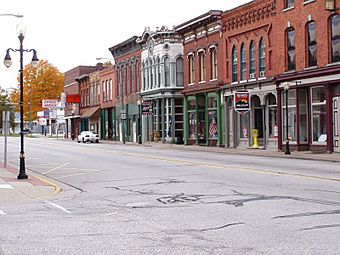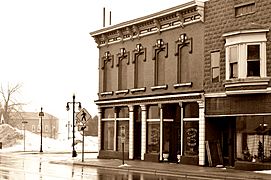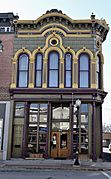Constantine Historic Commercial District facts for kids
Quick facts for kids |
|
|
Constantine Historic Commercial District
|
|

Washington Street, looking south
|
|
| Location | Washington St. between Second and Water & Water St. between White Pigeon and 125 W. Water, Constantine, Michigan |
|---|---|
| Area | 5 acres (2.0 ha) |
| Architectural style | Greek Revival, Gothic Revival, Italianate |
| NRHP reference No. | 85002444 |
| Added to NRHP | September 17, 1985 |
The Constantine Historic Commercial District is a special area in Constantine, Michigan. It's filled with old shops and buildings. You can find it along Washington Street, between Second and Water Streets, and also on Water Street. This district was added to the National Register of Historic Places in 1985 because of its important history and unique buildings.
Contents
A Look Back in Time
Constantine started as a small settlement in 1828. By 1830, it had a mill and five families. The village was officially planned out in 1831. It was easy to reach from the Chicago Road, which helped it grow. Constantine soon became the main town in the area. By 1840, over 800 people lived there!
Early businesses were built near the river. They used the river's power and easy transportation. Shops first appeared along Water Street. As the village grew, more merchants opened stores on Washington Street.
Early Buildings and Changes
The first commercial buildings were made of wood. They were built in the Greek Revival style. Many of these old wooden buildings were later destroyed by fires. However, five of them still stand in the district today. One building at 145 S. Washington still looks like it did in the 1850s. The Barry warehouse at 125 W. Water is another example. It was owned by John S. Barry, who was Michigan's governor three times!
Constantine did not get a railroad until the 1870s. This meant other towns became more important for shipping goods. But in the 1870s, many fancy new buildings were constructed. These were in the Italianate style.
Modern Times
As the 1900s began, new development happened outside the district. Almost all the buildings in this historic area were built before 1916. By the 1950s, new shopping areas outside downtown started to attract customers. But in the 1970s, people began to fix up and improve the downtown area again.
What Makes It Special?
The Constantine Historic Commercial District covers about 5 acres. It has 34 old buildings, including shops and homes. Most of these buildings were built between the mid-1800s and early 1900s. They show off Greek Revival and Italianate styles.
What's really cool is how well the old storefronts have been kept. Unlike many other historic shopping areas, about three-quarters of the buildings here still have their original street-level designs!
Notable Buildings to See
Here are some of the most interesting buildings in the district:
- Simons Block (120-138 S. Washington): This building was built in 1875. It was likely for John W. Simons' general store. It's the only three-story building in the district. Look for its large metal roof edge and arched windows. The ground floor still has its original entrances and display windows.
- 140 S. Washington: Built in 1870 for a clothing store, this building is unique. It mixes Gothic and Italianate styles. You can see Gothic arched windows with Italianate brickwork.
- 150 S. Washington: This Italianate building was built in 1877. It started as a clothing store. Since 1904, it has been a general and hardware store.
- Art Gallery Building (156 S. Washington): This building was constructed in 1877. George I. Crossett used the first floor for his drug store. He had a photography studio on the second floor. It has a special cast iron front on its upper floor.
- Wells and Calam Block (117 S. Washington): Built in 1870, this building housed the Wells and Calam general store. It's a very detailed Italianate building.
- 145 S. Washington: This is an 1850s Greek Revival building. It was built for Clinton Doolittle, who made harnesses. Even though it has new siding, its storefront still has the original design. It has two tall windows with a recessed door in the middle.
- The Barry Warehouse (125 W. Water): This old warehouse doesn't look as grand as it once did. But it's important because of its connection to John S. Barry, who was Michigan's governor three times.
- 122 E. Water: This brick Italianate building was built in 1885. It's known for its pretty tile and terra cotta decorations. It also has stained glass in the windows above the doors.
Gallery





